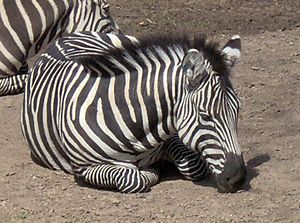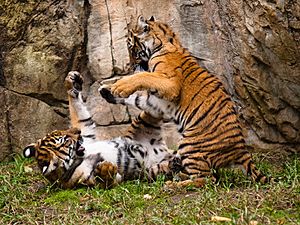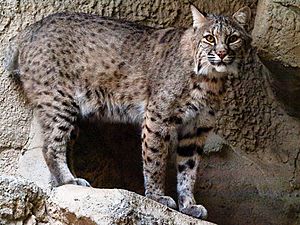Fort Worth Zoo facts for kids
 |
|
| Date opened | 1909 |
|---|---|
| Location | Fort Worth, Texas, United States of America |
| Land area | 64 acres (26 ha) |
| Coordinates | 32°43′19″N 97°21′24″W / 32.7219°N 97.3566°W |
| No. of species | 542 |
| Memberships | AZA ZAA WAZA |
The Fort Worth Zoo is a super cool place in Fort Worth, Texas. It's home to about 7,000 different animals from all over the world! Many magazines and newspapers, like USA Today, have called it one of the best zoos in the country.
The Fort Worth Zoo is officially recognized by important groups like the Association of Zoos and Aquariums (AZA). This means they meet high standards for animal care and conservation.
Contents
Discovering the Zoo's Past
The Fort Worth Zoo first opened its doors in 1909. Back then, it was much smaller. It only had a few animals, like one African lion, two bear cubs, an alligator, and some rabbits. For a long time, the city of Fort Worth ran the zoo.
In 1939, a group called the Zoological Society was formed. They helped raise extra money to buy more animals and improve the zoo. One famous early exhibit was Monkey Island, built in 1937. It changed over the years, housing sea lions, small South American mammals, and even parrots. Today, it's home to beautiful flamingos!
A special building for reptiles and amphibians, called the Herpetarium, opened in 1960. It was very advanced for its time. It had many different habitats for snakes, lizards, and frogs. It even had a zoo hospital inside!
In 1991, the Fort Worth Zoological Association took over managing the zoo. This led to many exciting new exhibits. In the 1990s, they opened places like World of Primates and Asian Falls. They also added Raptor Canyon, a cheetah exhibit, and Insect City. A new vet center opened in 1998 to help keep all the animals healthy.
The 2000s brought even more changes. In 2001, Texas Wild! opened, showing off animals native to Texas. The Great Barrier Reef exhibit, with its amazing underwater creatures, opened in 2005. The old Herpetarium closed in 2009. It was replaced by the awesome Museum of Living Art (MOLA) in 2010.
The Zoo's Exciting Future
The zoo has big plans for the future! In 2016, they announced a huge project called "A Wilder Vision." This plan includes building new exhibits and making existing ones even better. It also means new places to eat and more ways to learn about animals.
The first part of this plan, a new African Savanna, opened in 2018. Then, in 2021, an expanded elephant exhibit called Elephant Springs opened. More exciting projects are coming soon! These include new homes for African and Asian carnivores. A brand new "Forests & Jungles" section is also planned to open in 2027. This new area will feature animals like okapis, Sumatran orangutans, and jaguars.

Amazing Animal Exhibits

The Fort Worth Zoo has many incredible areas to explore. Some of the main exhibits include Penguins, World of Primates, the new Predators of Asia and Africa, Elephant Springs, and Texas Wild! Each area lets you see different animals from around the world.
Penguin Paradise
This indoor exhibit is a cool place to see African penguins. You can watch them waddle on the "beach" or swim underwater. It's also home to southern rockhopper penguins and common eider birds.
World of Primates
Opened in 1992, this 2.5-acre exhibit is full of monkeys and apes! You can walk through a tropical rainforest area that is now an aviary. Here, you'll see many different bird species. As you explore, you'll also spot western lowland gorillas, Sumatran orangutans, mandrills, and bonobos.
Elephant Springs
Elephant Springs opened in April 2021. It's a huge, updated home for the zoo's Asian elephants. Before seeing the elephants, you can visit the River Village. There's also a great viewing area for Indian rhinoceroses. You can even watch an elephant show in the Demonstration Area!
Predators of Asia and Africa
This exciting new exhibit opened in June 2023. It has large yards for amazing carnivores. You can see lions, cheetahs, African wild dogs, and African leopards. The exhibit also features Sumatran tigers, striped hyenas, and clouded leopards. Plus, there are aviaries with many different African and Asian birds.
Raptor Canyon
Raptor Canyon is a large aviary that opened in 1993. It's home to many impressive birds of prey. You can see crowned eagles, Andean condors, harpy eagles, and different types of vultures.
Flamingo Bay
Flamingo Bay is where you can find two types of flamingos at the zoo. You'll see beautiful American flamingos and Chilean flamingos. The zoo has even successfully bred these colorful birds!
Australian Outback and Great Barrier Reef
This exhibit has been updated to include the Great Barrier Reef. In the Australian Outback, you'll find red kangaroos. The Great Barrier Reef part has three large tanks with over 10,000 gallons of water! It's home to 500 aquatic animals, including clownfish, angelfish, stingrays, and colorful corals.
African Savanna
Opened in 2018, the African Savanna lets you see animals from Africa. You can spot reticulated giraffes, ostriches, and southern ground hornbills. There's even an elevated boardwalk where you can feed the giraffes! You'll also see southern black rhinos, hippopotamuses, and a group of meerkats.
Texas Wild!
Texas Wild! opened in 2001 to show off animals that live right here in Texas. It has different sections representing parts of the state. Texas Town has a fun play barn and a carousel.
- High Plains and Prairies: This area shows animals from the Panhandle. You might see swift foxes, greater roadrunners, and black-tailed prairie dogs.
- Pineywoods and Swamps: This section represents East Texas. It's home to red wolves, North American river otters, and American black bears.
- Gulf Coast: Here you'll find animals from Southern Texas, like roseate spoonbills and American white pelicans.
- Brush Country: This area shows animals from Southern Texas. You can see bobcats, cougars, jaguars, and ocelots.
Museum of Living Art (MOLA)
The Museum of Living Art, or MOLA, is a huge, modern building for reptiles and amphibians. It opened in 2010 and houses over 5,000 animals! You can see a giant saltwater crocodile, Aldabra giant tortoises, and a king cobra. The zoo's Komodo dragons also live here.
Helping Animals and Nature
The Fort Worth Zoo is very involved in helping animals in the wild. They have a special fund called the Arthur A. Seeligson Jr. Conservation Fund. This fund gives money to scientists and groups working to protect Texas wildlife. For example, they've helped projects for Houston toads and alligator snapping turtles.
The zoo's own scientists also work on many conservation projects. They help increase populations of endangered species like the Anegada rock iguana and the Panamanian golden frog.
The Fort Worth Zoo partners with many other conservation groups around the world. They work with organizations like the International Elephant Foundation and the Turtle Survival Alliance. These partnerships help protect animals in over 30 countries!
Art at the Zoo
The zoo also has some cool art! One famous piece is a 40-foot iguana sculpture named Iggy. It sits on the roof of the animal hospital. This giant iguana was created by artist Bob "Daddy-O" Wade.



